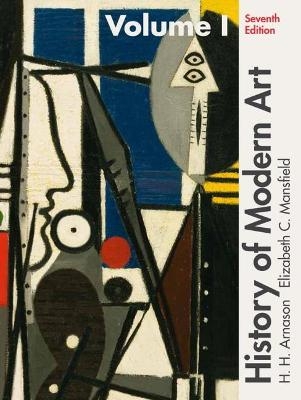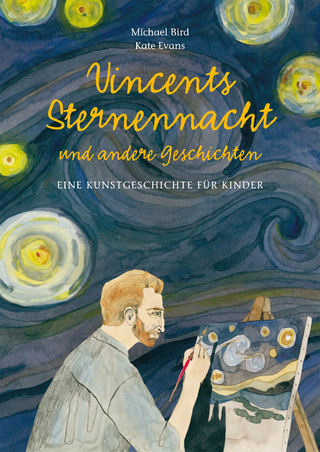
History of Modern Art, Volume 1
Pearson (Verlag)
978-0-205-25948-9 (ISBN)
- Keine Verlagsinformationen verfügbar
- Artikel merken
History of Modern Art is a visual comprehensive overview of the modern art field. It traces the trends and influences in painting, sculpture, photography and architecture from the mid-nineteenth century to the present day. The seventh edition deepens its discussions on social conditions that have affected the production and reception of modern and contemporary art.
Learning Goals
Upon completing this book, readers should be able to:
Understand the origins of modern art
Provide an analysis of artworks based on formal and contextual elements
Recognize the influences of social conditions on modern art
NOTE: MySearchLab does not come automatically package with this text. To purchase MySearchlab, please visit: www.mysearchlab.com or you can purchase a ValuePack of teh text + MySearchLab: Valuepack ISBN-10: 0205955517/ ValuePack ISBN-13: 9780205955510
Elizabeth C. Mansfield is Vice President for Scholarly Programs at the National Humanities Center in Research Triangle Park, North Carolina. She has taught art history at New York University and the University of the South in Sewanee, Tennessee . A scholar of modern European art and art historiography, her publications include books and articles on topics ranging from the origins of modernism to Picasso’s Demoiselles d’Avignon to the contemporary performance and body art of Orlan. Her 2007 book Too Beautiful to Picture: Zeus, Myth, and Mimesis was awarded the College Art Association’s Charles Rufus Morey book prize. The late H.H. Arnason was a distinguished art historian, educator, and museum administrator who for many years was Vice President for Art Administration of the Solomon Guggenheim Museum in New York. He began his professional life in academia, teaching at Northwestern University, University of Chicago, and the University of Hawaii. From 1947 to 1961, Arnason was Professor and Chairman of the Department of Art at the University of Minnesota.
In this Section:
Brief Table of Contents
Full Table of Contents
BRIEF TABLE OF CONTENTS:
Chapter 1: The Origins of Modern Art
Chapter 2: The Search for Truth: Early Photography, Realism, and Impressionism
Chapter 3: Post-Impressionism
Chapter 4: Arts and Crafts, Art Nouveau, and the Beginnings of Expressionism
Chapter 5: The New Century: Experiments in Color and Form
Chapter 6: Expressionism in Germany and Austria
Chapter 7: Cubism
Chapter 8: Early Modern Architecture
Chapter 9: European Art after Cubism
Chapter 10: Picturing the Wasteland: Western Europe during World War I
Chapter 11: Art in France after World War I
Chapter 12: Clarity, Certainty, and Order: De Stijl and the Pursuit of Geometric Abstraction
Chapter 13: Bauhaus and the Teaching of Modernism
Chapter 14: Surrealism
Chapter 15: American Art Before World War II
Chapter 16: Abstract Expressionism and the New American Sculpture
Chapter 17: Postwar European Art
Chapter 18: Nouveau Réalisme and Fluxus
Chapter 19: Taking Chances with Popular Culture
Chapter 20: Playing by the Rules: Sixties Abstraction
Chapter 21: Modernism in Architecture at Mid-Century
Chapter 22: Conceptual and Activist Art
Chapter 23: Post-Minimalism, Earth Art, and New Imagists
Chapter 24: Postmodernism
Chapter 25: Painting through History
Chapter 26: New Perspectives on Art and Audience
Chapter 27: Contemporary Art and Globalization
FULL TABLE OF CONTENTS:
Chapter 1: The Origins of Modern Art
Making Art and Artists: The Role of the Critic
The Modern Artist
What Does It Mean to Be an Artist?: From Academic Emulation toward Romantic Originality
Making Sense of a Turbulent World: The Legacy of Neoclassicism and Romanticism
Chapter 2: The Search for Truth: Early Photography, Realism, and Impressionism
New Ways of Seeing: Photography and its Influence
Only the Truth: Realism
Seizing the Moment: Impressionism and the Avant-Garde
From Realism to Impressionism
Nineteenth-Century Art in the United States
Chapter 3: Post-Impressionism
The Poetic Science of Color: Seurat and the Neo-Impressionist
Form and Nature: Paul Cézanne
The Triumph of Imagination: Symbolism
An Art Reborn: Rodin and Sculpture at the Fin de Siècle
Primitivism and the Avant-Garde: Gauguin and Van Gogh
A New Generation of Prophets: The Nabis
Montmartre: At Home with the Avant-Garde
Chapter 4: Arts and Crafts, Art Nouveau, and the Beginnings of Expressionism
“A Return to Simplicity”: The Arts and Crafts Movement and Experimental
Architecture
Experiments in Synthesis: Modernism beside the Hearth
With Beauty at the Reins of Industry: Aestheticism and Art Nouveau
Natural Forms for the Machine Age: The Art Nouveau Aesthetic
Painting and Graphic Art
Toward Expressionism: Late Nineteenth-Century Avant-Garde Painting beyond France
Chapter 5: The New Century: Experiments in Color and Form
Fauvism
“Purity of Means” in Practice: Henri Matisse’s Early Career
“Wild Beasts” Tamed: Derain, Vlaminck, and Dufy
Religious Art for a Modern Age: Georges Rouault
The Belle Époque on Film: The Lumière Brothers and Lartigue
Modernism on a Grand Scale: Matisse’s Art after Fauvism
Forms of the Essential: Constantin Brancusi
Chapter 6: Expressionism in Germany and Austria
From Romanticism to Expressionism: Corinth and Modersohn-Becker
Spanning the Divide between Romanticism and Expressionism: Die Brücke
The Spiritual Dimension: Der Blaue Reiter
Expressionist Sculpture
Self-Examination: Expressionism in Austria
Chapter 7: Cubism
Immersed in Tradition: Picasso’s Early Career
Beyond Fauvism: Braque’s Early Career
“Two Mountain Climbers Roped Together”: Braque, Picasso, and the
Development of Cubism
Constructed Spaces: Cubist Sculpture
An Adaptable Idiom: Developments in Cubist Painting in Paris
Other Agendas: Orphism and Other Experimental Art in
Chapter 8: Early Modern Architecture
“Form Follows Function”: The Chicago School and the Origins of the Skyscraper
Modernism in Harmony with Nature: Frank Lloyd Wright
Temples for the Modern City: American Classicism 1900—15
New Simplicity Versus Art Nouveau: Vienna Before World War I
Tradition and Innovation: The German Contribution to Modern Architecture
Toward the International Style: The Netherlands and Belgium
Chapter 9: European Art after Cubism
Fantasy Through Abstraction: Chagall and the Metaphysical School
“Running on Shrapnel”: Futurism in Italy
“Our Vortex is Not Afraid”: Wyndham Lewis and Vorticism
A World Ready for Change: The Avant-Garde in Russia
Utopian Visions: Russian Constructivism
Chapter 10: Picturing the Wasteland: Western Europe during World War I
The World Turned Upside Down: The Birth of Dada
“Her Plumbing and Her Bridges”: Dada Comes to America
“Art is Dead”: Dada in Germany
Idealism and Disgust: The “New Objectivity” in Germany
Chapter 11: Art in France after World War I
Eloquent Figuration: Les Maudits
Dedication to Color: Matisse’s Later Career
Celebrating the Good Life: Dufy’s Later Career
Eclectic Mastery: Picasso’s Career after the War
Sensuous Analysis: Braque’s Later Career
Austerity and Elegance: Léger, Le Corbusier, and Ozenfant
Chapter 12: Clarity, Certainty, and Order: De Stijl and the Pursuit of Geometric Abstraction
The de Stijl Idea
Mondrian: Seeking the Spiritual Through the Rational
Van Doesburg, de Stijl, and Elementarism
De Stijl Realized: Sculpture and Architecture
Chapter 13: Bauhaus and the Teaching of Modernism
Audacious Lightness: The Architecture of Gropius
The Building as Entity: The Bauhaus
The Vorkurs: Basis of the Bauhaus Curriculum
Die Werkmeistern: Craft Masters at the Bauhaus
From Bauhaus Dessau to Bauhaus U.S.A.
Chapter 14: Surrealism
Breton and the Background to Surrealism
“Art is a Fruit”: Arp’s Later Career
Hybrid Menageries: Ernst’s Surrealist Techniques
“Night, Music, and Stars”: Miró and Organic—Abstract Surrealism
Methodical Anarchy: André Masson
Enigmatic Landscapes: Tanguy and Dalí
Surrealism beyond France and Spain: Magritte, Delvaux, Bellmer, Matta, and Lam
Women and Surrealism: Oppenheim, Cahun, Maar, Tanning, and Carrington
Never Quite “One of Ours”: Picasso and Surrealism
Pioneer of a New Iron Age: Julio González
Surrealism’s Sculptural Language: Giacometti’s Early Career
Surrealist Sculpture in Britain: Moore
Bizarre Juxtapositions: Photography and Surrealism
Chapter 15: American Art Before World War II
American Artist as Cosmopolitan: Romaine Brooks
The Truth about America: The Eight and Social Criticism
A Rallying Place for Modernism: 291 Gallery and the Stieglitz Circle
Coming to America: The Armory Show
Sharpening the Focus on Color and Form: Synchromism and Precisionism
The Harlem Renaissance
Painting the American Scene: Regionalists and Social Realists
Documents of an Era: American Photographers Between the Wars
Social Protest and Personal Pain: Mexican Artists
The Avant-Garde Advances: Toward American Abstract Art
Sculpture in America Between the Wars
Chapter 16: Abstract Expressionism and the New American Sculpture
Mondrian in New York: The Tempo of the Metropolis
Entering a New Arena: Modes of Abstract Expressionism
The Picture as Event: Experiments in Gestural Painting
Complex Simplicities: Color Field Painting
Drawing in Steel: Constructed Sculpture
Textures of the Surreal: Biomorphic Sculpture and Assemblage
Expressive Vision: Developments in American Photography
Chapter 17: Postwar European Art
Re-evaluations and Violations: Figurative Art in France
A Different Art: Abstraction in France
Postwar Juxtapositions: Figuration and Abstraction in Italy and Spain
“Forget It and Start Again”: The CoBrA Artists and Hundertwasser
The Postwar Body: British Sculpture and Painting
Marvels of Daily Life: European Photographers
Chapter 18: Nouveau Réalisme and Fluxus
“Sensibility in Material Form”: Klein
Fluxus
Chapter 19: Taking Chances with Popular Culture
“This is Tomorrow”: Pop Art in Britain
Signs of the Times: Pop Art in the United States
Getting Closer to Life: Happenings and Environments
“Just Look at the Surface”: The Imagery of Everyday Life
Poetics of the “New Gomorrah”: West Coast Artists
Personal Documentaries: The Snapshot Aesthetic in American Photography
Chapter 20: Playing by the Rules: Sixties Abstraction
Drawing the Veil: Post Painterly Abstraction
At an Oblique Angle: Diebenkorn
Forming the Unit: Hard-Edge Painting
Seeing Things: Op Art
New Media Mobilized: Motion and Light
The Limits of Modernism: Minimalism
Complex Unities: Photography and Minimalism
Chapter 21: Modernism in Architecture at Mid-Century
“The Quiet Unbroken Wave”: The Later Work of Wright and Le Corbusier
Purity and Proportion: The International Style in America
Internationalism Contextualized: Developments in Europe, Latin America, Asia, and Australia
Breaking the Mold: Experimental Housing
Arenas for Innovation: Major Public Projects
Chapter 22: Conceptual and Activist Art
Art as Language
Conceptual Art as Cultural Critique
The Medium Is the Message: Early Video Art
When Art Becomes Artist: Body Art
Radical Alternatives: Feminist Art
Erasing the Boundaries between Art and Life: Later Feminist Art
Invisible to Visible: Art and Racial Politics
Chapter 23: Post-Minimalism, Earth Art, and New Imagists
Metaphors for Life: Process Art
Big Outdoors: Earthworks and Land Art
Public Statements: Monuments and Large-Scale Sculpture
Body of Evidence: Figurative Art
Animated Surfaces: Pattern and Decoration
Figure and Ambiguity: New Image Art
Chapter 24: Postmodernism
Postmodernism in Architecture
“Complexity and Contradiction”: The Reaction Against Modernism Sets In
In Praise of “Messy Vitality”: Postmodernist Eclecticism
Ironic Grandeur: Postmodern Architecture and History
What Is a Building?: Constructivist and Deconstructivist Architecture
Structure as Metaphor: Architectural Allegories
Flexible Spaces: Architecture and Urbanism
Postmodern Practices: Breaking Art History
Chapter 25: Painting through History
Primal Passions: Neo-Expressionism
Searing Statements: Painting as Social Conscience
In the Empire of Signs: Neo-Geo
The Sum of Many Parts: Abstraction in the 1980s
Taking Art to the Streets: Graffiti and Cartoon Artists
Painting Art History
Chapter 26: New Perspectives on Art and Audience
Commodity Art
Postmodern Arenas: Installation Art
Strangely Familiar: British and American Sculpture
Reprise and Reinterpretation: Art History as Art
New Perspectives on Childhood and Identity
The Art of Biography
Meeting Points: New Approaches to Abstraction
Chapter 27: Contemporary Art and Globalization
Lines That Define Us: Locating and Crossing Borders
Skin Deep: Identity and the Body
Occupying the Art World Globalization and Arts Institutions
| Erscheint lt. Verlag | 17.4.2013 |
|---|---|
| Sprache | englisch |
| Maße | 220 x 291 mm |
| Gewicht | 1380 g |
| Themenwelt | Kunst / Musik / Theater ► Kunstgeschichte / Kunststile |
| Kinder- / Jugendbuch ► Sachbücher ► Kunst / Musik | |
| ISBN-10 | 0-205-25948-0 / 0205259480 |
| ISBN-13 | 978-0-205-25948-9 / 9780205259489 |
| Zustand | Neuware |
| Haben Sie eine Frage zum Produkt? |
aus dem Bereich


